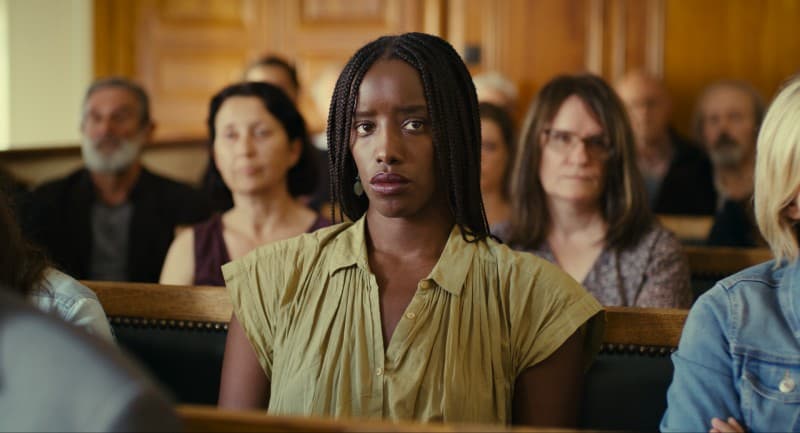
As part of our coverage of the 60th annual New York Film Festival, Will DiGravio reviews Alice Diop’s debut narrative feature, Saint Omer. Follow along with more coverage in our New York Film Festival archives.
Documentarian Alice Diop’s first narrative feature, Saint Omer, is a deeply moving, highly inventive courtroom drama that will devastate and captivate audiences with its depiction of a mother on trial for killing her young child. It is the way Diop places and moves the camera throughout the familiar, otherwise bland space of the wood-paneled courtroom that makes Saint Omer a cinematic achievement, especially in its slowest, most complex moments.
The film opens with Kayije Kagame as Rama, a professor, and novelist, going about her daily life. Diop shows the viewer Rama lecturing before her students, eating dinner with her mother, with whom she has a complicated past and relationship, and talking about making improvements to the home she shares with her husband. Clearly, though, something is weighing on her mind.
Rama travels from Paris to Saint-Omer, located near the Northern coast of France, to research a prospective book project. There, a woman named Laurence Coly (Guslagie Malanga), a former student and immigrant from Senegal, stands trial for murder. To the authorities, she confessed leaving her 15-month-old daughter on the beach, where the child was swept up by the waves and drowned at sea. The film takes its inspiration from real events that occurred in 2016. Diop, herself of Senegalese descent, attended the trial. So moved by the proceedings and its resonance for her, Diop explained, she set out to make this film.
But do not mistake the film’s relationship with reality for the kind associated with docudramas or commercial “based on true events” tales. In fact, if not for Diop’s discussion of the real trial during interviews about the film’s creation, one would get no hint that any actual events took place. Saint Omer, which Diop co-wrote with Amrita David and Marie NDiaye, is a rigorously stylized work that leans into its own subjectivity. One feels the presence of the director even without knowing the backstory.
Diop and cinematographer Claire Mathon shoot the courtroom in ways that challenge our relationship with the space. The camera slowly pans towards and away from Laurence. Sometimes, the camera brings us right into the face of an attorney, who almost seems aware of the device’s presence. Arguing before a judge is just another kind of performance, after all. And most effectively, when a character, namely Laurence, begins to speak before the courtroom, Diop often cuts away to another character. Such cuts are not typical reaction shots. The camera lingers, heightening the subjective and giving the viewer space to reflect on what each of the characters might be thinking and feeling.
Sexism and racism, for example, are recurring themes in the trial. And class too. At one point, for instance, Rama’s literary agent expresses dismay that Laurence can speak so well. The events of the trial begin to remind Rama of her relationship with her own mother. Diop flashes back to Rama’s childhood, foregrounding feeling over merely giving the facts of an event. Rama clearly sees much of herself in Laurence and begins to feel deep empathy for her. We begin to understand her trauma and the circumstances in which she found herself. We also learn more about her life now. And Diop leans into the ambiguity of it all. The film itself comes to stand in direct opposition to the performativity of the trial it depicts. Trials are interested in litigating right and wrong. Diop’s film exists in the in between space. It is far more interested in affect and mutual understanding.
One of the film’s great triumphs is the way in which it depicts the physical space of the courtroom. The camera captures the décor, the officials, the defendant, and those in the audience from a variety of angles. We get to understand the physical layout of the court and each person’s position within it. This breeds tension and heightens the drama. For example, when something happens and the film viewer might expect Diop to cut to Rama for a reaction, she does not. Or, when we want to see a certain character’s face, Diop shows only the back of the head. The film masterfully plays with our expectations. Even when we do not see a character, we know exactly where they are. We feel their presence, and we again wonder about their experience of the unfolding events.
Diop’s stylization of the trial foregrounds the very nature of criminal justice: often, it is just an exploitative show. Laurence is repeatedly dehumanized by the state and those in the courtroom. Saint Omer finds a way to depict this all-too-common occurrence without perpetuating or merely duplicating that which it is critiquing. The key is found in the powerfully precise performances of Kagame and Malanga. There is a moment when the two characters lock eyes. Laurence smiles. In that moment, the understanding, the connection, and the humanity are palpable.
Related Topics: NYFF

